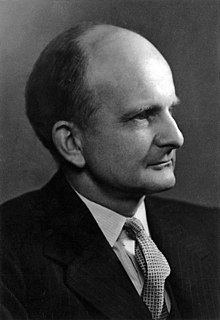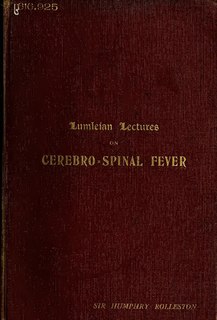
The BMJ is a weekly peer-reviewed medical trade journal, published by the trade union the British Medical Association (BMA). The BMJ has editorial freedom from the BMA. It is one of the world's oldest general medical journals. Originally called the British Medical Journal, the title was officially shortened to BMJ in 1988, and then changed to The BMJ in 2014. The journal is published by BMJ Publishing Group Ltd, a subsidiary of the British Medical Association (BMA). The editor-in-chief of The BMJ is Kamran Abbasi, who was appointed in January 2022.
An overwhelming post-splenectomy infection (OPSI) is a rare but rapidly fatal infection occurring in individuals following removal of the spleen. The infections are typically characterized by either meningitis or sepsis, and are caused by encapsulated organisms including Streptococcus pneumoniae. It is a medical emergency and requires immediate treatment. Death has been reported to occur within 12 hours.

Nalidixic acid is the first of the synthetic quinolone antibiotics.

Primidone, sold under various brand names, is a barbiturate medication that is used to treat partial and generalized seizures, as well as essential tremors. It is taken by mouth.

Practolol is a selective beta blocker that has been used in the emergency treatment of cardiac arrhythmias. Practolol is no longer used as it is highly toxic despite the similarity of its chemical formula to propranolol. After its introduction, keratoconjunctivitis sicca, conjunctival scarring, fibrosis, metaplasia, and shrinkage developed in 27 patients as an adverse reaction to practolol. Rashes, nasal and mucosal ulceration, fibrous or plastic peritonitis, pleurisy, cochlear damage, and secretory otitis media also occurred in some cases. Three patients suffered profound visual loss though most retained good vision. Symptoms and signs improved on withdrawal of the drug, but reduction of tear secretion persisted in most patients.
Caplan's syndrome is a combination of rheumatoid arthritis (RA) and pneumoconiosis that manifests as intrapulmonary nodules, which appear homogenous and well-defined on chest X-ray.

Richard Alan John Asher, FRCP was an eminent British endocrinologist and haematologist. As the senior physician responsible for the mental observation ward at the Central Middlesex Hospital he described and named Munchausen syndrome in a 1951 article in The Lancet.
Guillain–Barré syndrome (GBS) is a rapid-onset muscle weakness caused by the immune system damaging the peripheral nervous system. Typically, both sides of the body are involved, and the initial symptoms are changes in sensation or pain often in the back along with muscle weakness, beginning in the feet and hands, often spreading to the arms and upper body. The symptoms may develop over hours to a few weeks. During the acute phase, the disorder can be life-threatening, with about 15% of people developing weakness of the breathing muscles and, therefore, requiring mechanical ventilation. Some are affected by changes in the function of the autonomic nervous system, which can lead to dangerous abnormalities in heart rate and blood pressure.
Benoxaprofen, also known as Benoxaphen, is a chemical compound with the formula C16H12ClNO3. It is a nonsteroidal anti-inflammatory drug (NSAID) and was marketed under the brand name Oraflex in the United States and as Opren in Europe by Eli Lilly and Company. Lilly suspended sales of Oraflex in 1982 after reports from the British government and the U.S. Food and Drug Administration (FDA) of adverse effects and deaths linked to the drug.

The history of chronic fatigue syndrome is thought to date back to the 19th century and before.
Chronic fatigue syndrome (CFS) is an illness with a long history of controversy. For years, many professionals within the medical community did not recognize CFS as a true condition, nor was there agreement on its prevalence. There has been much disagreement over the pathophysiology of chronic fatigue syndrome, how it should be diagnosed, and how to treat it.

Amiphenazole (Daptazile) is a respiratory stimulant traditionally used as an antidote for barbiturate or opiate overdose, usually in combination with bemegride, as well as poisoning from other sedative drugs and treatment of respiratory failure from other causes. It was considered particularly useful as it could counteract the sedation and respiratory depression produced by morphine but with less effect on analgesia. It is still rarely used in medicine in some countries, although it has largely been replaced by more effective respiratory stimulants such as doxapram and specific opioid antagonists such as naloxone.

The Lumleian Lectures are a series of annual lectures started in 1582 by the Royal College of Physicians and currently run by the Lumleian Trust. The name commemorates John Lumley, 1st Baron Lumley, who with Richard Caldwell of the College endowed the lectures, initially confined to surgery, but now on general medicine. William Harvey did not announce his work on the circulation of the blood in the Lumleian Lecture for 1616 although he had some partial notes on the heart and blood which led to the discovery of the circulation ten years later. By that time ambitious plans for a full anatomy course based on weekly lectures had been scaled back to a lecture three times a year.

Mepiprazole is an anxiolytic drug of the phenylpiperazine group with additional antidepressant properties that is marketed in Spain. It acts as a 5-HT2A and α1-adrenergic receptor antagonist and inhibits the reuptake and induces the release of serotonin, dopamine, and norepinephrine to varying extents, and has been described as a serotonin antagonist and reuptake inhibitor (SARI). Controlled clinical trials of mepiprazole in patients with irritable bowel syndrome (IBS) were also carried out and suggested some benefits of the drug in relieving symptoms of IBS in some patients. Similarly to other phenylpiperazines like trazodone, nefazodone, and etoperidone, mepiprazole produces mCPP as an active metabolite.
The Bradshaw Lectures are prestigious lectureships given at the invitation of the Royal College of Physicians and the Royal College of Surgeons of England.

Henry Roy Dean, MD, LL.D, D.Sc, FRCP, also known as Prof. H. R. Dean, was a professor of Pathology at the University of Cambridge and Master of Trinity Hall, Cambridge.
Douglas Montagu Temple Gairdner FRCP was a Scottish paediatrician, research scientist, academic and author. Gairdner was principally known for a number of research studies in neonatology at a time when that subject was being developed as perhaps the most rewarding application of basic physiology to patient care, and later his most important contributions as editor, firstly editing Recent Advances in Paediatrics and then of Archives of Disease in Childhood for 15 years, turning the latter into an international journal of repute with its exemplary standards of content and presentation.

9-Carboxymethoxymethylguanine (CMMG) is a compound which is known as the principal metabolite of the antiviral medication aciclovir, and has been suggested as the causative agent in the neuropsychiatric side effects sometimes associated with these medications. These are mainly suffered by patients with kidney failure or otherwise decreased kidney function, and can include psychotic reactions, hallucinations, and rarely more complex disorders such as Cotard delusion. Patients suffering these symptoms following aciclovir treatment were found to have much higher levels of CMMG than normal, and since this is the first time Cotard delusion has been linked to a drug as a side effect, this discovery may be useful in the study of Cotard delusion and its treatment.
Professor Miles Weatherall (1920-2007) was a British pharmacologist.
Allan George Williams Whitfield (1909–1987) was an English physician.










